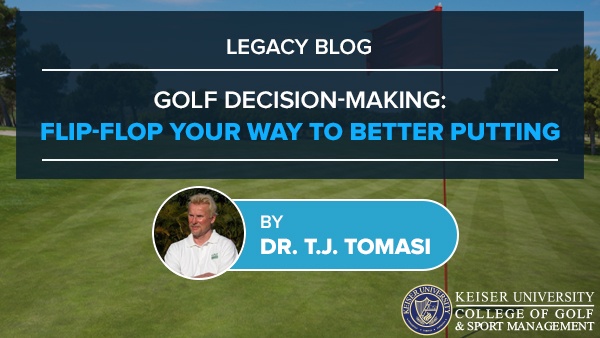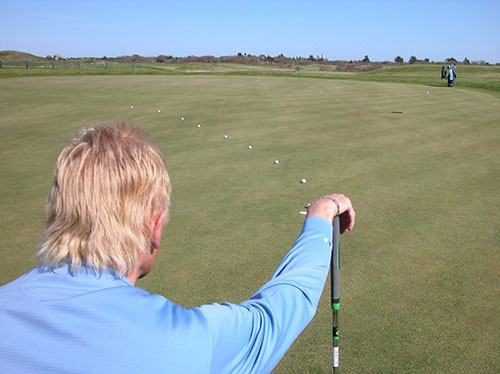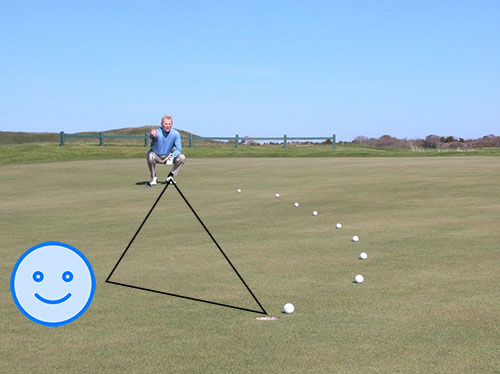Golf Decision-Making: Flip-Flop Your Way to Better Putting

A Legacy Post by Keiser University College of Golf Senior Faculty and Director of Research Dr. T. J. Tomasi (1940-2023)
In politics, the kiss of death is to be a flip-flopper. Unusual as it is, changing your mind because of new information is considered a character flaw in politicians. But in ‘real’ life, as General Douglas MacArthur said, “The hand closed permanently in a fist is useless in hand-to-hand combat.” In my opinion, we are much safer following the dictates of one of our greatest soldiers, who must have been a great fan of triangulation in golf, where changing one’s mind is the essence of the game.
Golf Strategy and Decision-Making
Golf strategy and decision-making play a pivotal role in the success of every golfer on the course. At its core, golf strategy involves analyzing the layout of the course, assessing environmental factors such as wind and terrain, and formulating a game plan to navigate each hole efficiently. Effective decision-making in golf requires careful consideration of various factors, including distance to the hole, the location of hazards, and the player’s own skill level and strengths. A strategic approach to golf can lead to better shot selection, improved course management, and, ultimately, lower scores. Moreover, golf strategy is not only about executing shots but also about minimizing risks and maximizing opportunities to capitalize on scoring chances. Successful golfers often rely on a combination of experience, knowledge, and intuition to make informed decisions on the course. Developing a sound golf strategy and sharpening decision-making skills can lead to greater consistency, confidence, and success in the game. Through practice, analysis, and adaptation, golfers can refine their strategic approach and enhance their ability to navigate the challenges presented by each round.
Golf Course Strategy
Golf strategy on the course involves careful planning and decision-making to optimize performance and achieve the best possible score. Players must analyze the layout of each hole, considering factors such as distance, hazards, and terrain. By strategically selecting clubs and shot types, golfers can navigate the course effectively while minimizing risks and capitalizing on opportunities. Additionally, understanding one’s own strengths and weaknesses allows players to tailor their strategy to suit their game and maximize their chances of success. Ultimately, a well-executed golf strategy not only enhances performance but also contributes to a more enjoyable and rewarding experience on the course.
Golf Strategy Tips
The three vantage points from which you gather your “mind-changing info” match the three points on the triangle:
- From behind the hole (temporary commitment one)
- From mid-way to the hole, on the low side (temporary commitment two)
- From behind the ball (final commitment)
As you move from point to point on the triangle, your commitment to the line of the putt often changes. This is as it should be because, as you gather more information from different vantage points, your brain adjusts the line or curve of the putt automatically — wow, your brain is a handy thing to have around at putting time. The point is your brain needs to keep “changing its mind” until it gets it right, and it does this by processing the flow of information from triangulating. For your brain to do its thing, all you must pay is attention. So, make sure you have a putting routine designed to locate the target by gathering enough information about distance and direction to get the ball in the hole. Give your putting routine a permanent structure, so it’s an integral part of the putt rather than a trivial option that comes before the real thing.

To accurately peg the position of the cup in relation to my ball, I need to use triangulation, where I look at the line from three vantage points. I start behind the hole, but when you use just one position to determine the location of an object, you’re likely to encounter parallax – i.e., distortion via the position of the observer. That’s why surveyors use more than one position to measure the exact location of objects – they can’t afford to be fooled, and neither can you.

Next, I’ll move to the point on the triangle marked by the smiley face, and lastly, behind the ball for my final read.
Learn more!
Want more tips? If you want to take your game to the next level, contact our team at Keiser University’s College of Golf & Sport Management today. With our dedication and experience, we can elevate your game to new heights together. Give us a call today at 888-355-4465.














